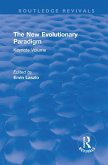Evolutionary Perspectives on Environmental Problems
Herausgeber: Mysterud, Iver
Evolutionary Perspectives on Environmental Problems
Herausgeber: Mysterud, Iver
- Gebundenes Buch
- Merkliste
- Auf die Merkliste
- Bewerten Bewerten
- Teilen
- Produkt teilen
- Produkterinnerung
- Produkterinnerung
The twenty-first century presents an increasing number of environmental problems, including toxic pollution, global warming, destruction of tropical forests, extinction of biological diversity, and depletion of natural resources
Andere Kunden interessierten sich auch für
![Perspectives on Genetic Discrimination Perspectives on Genetic Discrimination]() Thomas LemkePerspectives on Genetic Discrimination185,99 €
Thomas LemkePerspectives on Genetic Discrimination185,99 €![Complex Systems and Evolutionary Perspectives on Organisations Complex Systems and Evolutionary Perspectives on Organisations]() Eve Mitleton-Kelly (ed.)Complex Systems and Evolutionary Perspectives on Organisations174,99 €
Eve Mitleton-Kelly (ed.)Complex Systems and Evolutionary Perspectives on Organisations174,99 €![The New Evolutionary Paradigm The New Evolutionary Paradigm]() The New Evolutionary Paradigm131,99 €
The New Evolutionary Paradigm131,99 €![Evolutionary Change Evolutionary Change]() Aron KatsenelinboigenEvolutionary Change46,99 €
Aron KatsenelinboigenEvolutionary Change46,99 €![Evolutionary History of the Robust Australopithecines Evolutionary History of the Robust Australopithecines]() Frederick E. GrineEvolutionary History of the Robust Australopithecines64,99 €
Frederick E. GrineEvolutionary History of the Robust Australopithecines64,99 €![The New Evolutionary Paradigm The New Evolutionary Paradigm]() The New Evolutionary Paradigm46,99 €
The New Evolutionary Paradigm46,99 €![The Functional and Evolutionary Biology of Primates The Functional and Evolutionary Biology of Primates]() Russell TuttleThe Functional and Evolutionary Biology of Primates170,99 €
Russell TuttleThe Functional and Evolutionary Biology of Primates170,99 €-
-
-
The twenty-first century presents an increasing number of environmental problems, including toxic pollution, global warming, destruction of tropical forests, extinction of biological diversity, and depletion of natural resources
Produktdetails
- Produktdetails
- Verlag: Routledge
- Seitenzahl: 380
- Erscheinungstermin: 15. Dezember 2006
- Englisch
- Abmessung: 235mm x 157mm x 25mm
- Gewicht: 700g
- ISBN-13: 9780202307541
- ISBN-10: 0202307549
- Artikelnr.: 21122762
- Herstellerkennzeichnung
- Libri GmbH
- Europaallee 1
- 36244 Bad Hersfeld
- gpsr@libri.de
- Verlag: Routledge
- Seitenzahl: 380
- Erscheinungstermin: 15. Dezember 2006
- Englisch
- Abmessung: 235mm x 157mm x 25mm
- Gewicht: 700g
- ISBN-13: 9780202307541
- ISBN-10: 0202307549
- Artikelnr.: 21122762
- Herstellerkennzeichnung
- Libri GmbH
- Europaallee 1
- 36244 Bad Hersfeld
- gpsr@libri.de
Iver Mysterud
Introduction
1: Human Nature and Resource Conservation
1: Human Behavioural Ecology and Environmental Conservation
2: The Evolved Psychological Apparatus of Human Decision-Making is One Source of Environmental Problems
2: The Ecological Noble Savage Hypothesis
3: Game Conservation or Efficient Hunting?
4: Behavioral Ecology of Conservation in Traditional Societies
5: Evolutionary Ecology and Resource Conservation
3: The Tragedy of the Unmanaged Commons
6: The Tragedy of the Unmanaged Commons
7: Closing the Commons
8: Revisiting the Commons
9: Grassland Conservation and the Pastoralist Commons
4: The Evolution of Discounting and Conspicuous Consumption
10: Conserving Resources For Children
11: Two Truths about Discounting and Their Environmental Consequences
12: Sex Differences in Valuations of the Environment?
13: The Evolution of Magnanimity
5: Overpopulation and Fertility Declines
14: Evolutionary Economics of Human Reproduction
15: More Status or More Children? Social Status, Fertility Reduction, and Long-Term Fitness
16: The Demographic Transition
6: Biophilia
17: Biophilia and the Conservation Ethic
18: Human Behavioral Ecology
Conclusion: Integrating the Biological and Social Sciences to Address Environmental Problems
1: Human Nature and Resource Conservation
1: Human Behavioural Ecology and Environmental Conservation
2: The Evolved Psychological Apparatus of Human Decision-Making is One Source of Environmental Problems
2: The Ecological Noble Savage Hypothesis
3: Game Conservation or Efficient Hunting?
4: Behavioral Ecology of Conservation in Traditional Societies
5: Evolutionary Ecology and Resource Conservation
3: The Tragedy of the Unmanaged Commons
6: The Tragedy of the Unmanaged Commons
7: Closing the Commons
8: Revisiting the Commons
9: Grassland Conservation and the Pastoralist Commons
4: The Evolution of Discounting and Conspicuous Consumption
10: Conserving Resources For Children
11: Two Truths about Discounting and Their Environmental Consequences
12: Sex Differences in Valuations of the Environment?
13: The Evolution of Magnanimity
5: Overpopulation and Fertility Declines
14: Evolutionary Economics of Human Reproduction
15: More Status or More Children? Social Status, Fertility Reduction, and Long-Term Fitness
16: The Demographic Transition
6: Biophilia
17: Biophilia and the Conservation Ethic
18: Human Behavioral Ecology
Conclusion: Integrating the Biological and Social Sciences to Address Environmental Problems
Introduction
1: Human Nature and Resource Conservation
1: Human Behavioural Ecology and Environmental Conservation
2: The Evolved Psychological Apparatus of Human Decision-Making is One Source of Environmental Problems
2: The Ecological Noble Savage Hypothesis
3: Game Conservation or Efficient Hunting?
4: Behavioral Ecology of Conservation in Traditional Societies
5: Evolutionary Ecology and Resource Conservation
3: The Tragedy of the Unmanaged Commons
6: The Tragedy of the Unmanaged Commons
7: Closing the Commons
8: Revisiting the Commons
9: Grassland Conservation and the Pastoralist Commons
4: The Evolution of Discounting and Conspicuous Consumption
10: Conserving Resources For Children
11: Two Truths about Discounting and Their Environmental Consequences
12: Sex Differences in Valuations of the Environment?
13: The Evolution of Magnanimity
5: Overpopulation and Fertility Declines
14: Evolutionary Economics of Human Reproduction
15: More Status or More Children? Social Status, Fertility Reduction, and Long-Term Fitness
16: The Demographic Transition
6: Biophilia
17: Biophilia and the Conservation Ethic
18: Human Behavioral Ecology
Conclusion: Integrating the Biological and Social Sciences to Address Environmental Problems
1: Human Nature and Resource Conservation
1: Human Behavioural Ecology and Environmental Conservation
2: The Evolved Psychological Apparatus of Human Decision-Making is One Source of Environmental Problems
2: The Ecological Noble Savage Hypothesis
3: Game Conservation or Efficient Hunting?
4: Behavioral Ecology of Conservation in Traditional Societies
5: Evolutionary Ecology and Resource Conservation
3: The Tragedy of the Unmanaged Commons
6: The Tragedy of the Unmanaged Commons
7: Closing the Commons
8: Revisiting the Commons
9: Grassland Conservation and the Pastoralist Commons
4: The Evolution of Discounting and Conspicuous Consumption
10: Conserving Resources For Children
11: Two Truths about Discounting and Their Environmental Consequences
12: Sex Differences in Valuations of the Environment?
13: The Evolution of Magnanimity
5: Overpopulation and Fertility Declines
14: Evolutionary Economics of Human Reproduction
15: More Status or More Children? Social Status, Fertility Reduction, and Long-Term Fitness
16: The Demographic Transition
6: Biophilia
17: Biophilia and the Conservation Ethic
18: Human Behavioral Ecology
Conclusion: Integrating the Biological and Social Sciences to Address Environmental Problems









